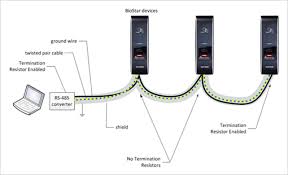Why does RS485 need to add a pull-down resistor?
The RS485 bus is a commonly used differential signal transmission method known for its strong anti-interference capabilities, long transmission rs485 distance, and ability to support a large number of nodes. It is widely used in communications, industrial automation, and other fields. However, one common issue in practical applications is whether pull-down resistors need to be added to the A and B lines of the 485 bus and what size these resistors should be. This article will analyze and explain this issue.
How Does the RS485 Bus Work?
First, it’s essential to understand the operating principle and signal characteristics of the RS485 bus. According to the RS485 standard, the 485 bus transmits differential signals through two lines (A and B), with data bits determined by the voltage difference between the two lines.
There are three states for data transmission on the RS485:
1. When the voltage difference \( V_{AB} = V_A – V_B \) exceeds +200mV, the RS485 transceiver outputs a logic ‘1’.
2. When \( V_{AB} \) is less than -200mV, the output is a logic ‘0’.
3. When \( V_{AB} \) is between -200mV and +200mV, the output is uncertain, which means it could be high or low.
How to Avoid Uncertain States?
Normally, we want the receiver to only recognize clear ‘0’ or ‘1’ states. Uncertain states should not occur on the RS485 bus. These uncertain states mainly occur under two conditions:
1. When the RS485 bus is idle, all transceivers are in the receive mode, and no transceiver is driving the bus. Consequently, without any source generating a differential voltage, the voltages on lines A and B are essentially equal, resulting in a differential voltage close to zero.
2. When the RS485 bus is open, meaning a transceiver is disconnected from the bus. In this case, the disconnected transceiver no longer influences the bus, leading to a nearly zero differential voltage among the remaining transceivers.
An uncertain state occurs when the output from the RS485 drivers is insufficient to create a voltage difference greater than 200mV between lines A and B. This situation means that the state of the bus no longer reflects the state of the drivers, making it impossible for the receivers to recognize the correct signals.
Preventing Uncertain States
To prevent uncertain states and ensure reliable communication, it is necessary to maintain a proper voltage difference even when the bus is idle or a line is disconnected. This can be achieved by adding pull-up resistors to line A and pull-down resistors to line B, ensuring a fixed differential voltage even when the bus is idle or open.
When choosing the value of these resistors, consider the following factors:
1. The pull-up and pull-down resistors should be small enough to ensure that the differential voltage during idle or open states exceeds +200mV or is less than -200mV (as required), thus avoiding uncertain states.
2. The resistors should be large enough to reduce power consumption and heat, without affecting the driving capacity and output voltage of the RS485 transceivers.
3. The resistors should match the input impedance of the RS485 transceivers, termination resistors, bus length, and number of nodes to ensure impedance matching and signal integrity.
Example Calculations
Suppose the internal differential input resistance \( R_{IN} \) is 15kΩ, \( V_{CC} \) is 3.3V, and \( RT \) is 120Ω. Using equal values for \( RU \) and \( RD \), you can calculate that \( R \) should ideally be between 0Ω and 239Ω to ensure that lines A and B are in a ‘data 1’ state under disconnected conditions.
For idle conditions, considering that most node devices add \( RU \) and \( RD \) resistors and terminate with \( RT \), you can derive a formula based on the number of nodes \( m \) with pull resistors and total nodes \( n \). This calculation helps determine the appropriate values for \( RU \) and \( RD \) based on actual node count.
However, the calculated values are ideal. In practice, pull-up and pull-down resistor values are often predetermined inside the nodes. Different node devices may have varying internal resistor values, and you must consider the node count when selecting these resistor values. Additionally, consider the driver chip’s load capacity; avoid setting very low values for pull resistors.
In summary, adding pull-down resistors to the A and B lines of the RS485 bus is essential to maintain a fixed differential voltage during idle or open states, preventing uncertain states that could lead to communication errors or failures. When selecting resistor values, you must consider power consumption, driver capacity, impedance matching, and other factors to ensure stable and reliable communication.
Practical Implementation and Recommendations
When implementing RS485 in your systems, consider the following recommendations to optimize performance and reliability:
1. Assess the Environment: Before selecting resistor values, consider the environmental factors where the RS485 bus will operate. Electromagnetic interference, temperature fluctuations, and physical obstructions can all influence the effective transmission characteristics of the bus.
2. Choose Appropriate Resistor Values:
1. Calculate Resistor Values: Based on the number of nodes and the configuration of your network (terminating resistors at each end, mid-point, etc.), calculate the optimal resistor values to maintain a differential voltage that clearly distinguishes between the logic levels.
2. Test Under Different Conditions: It’s advisable to test the bus under various conditions to ensure that the chosen resistors provide stability across all operational scenarios. This may involve adjusting resistor values based on trial and error to find the best fit for your specific application.
3. Monitor Bus Performance: Regular monitoring of the RS485 bus performance can help identify potential issues early. Tools like oscilloscopes or bus analyzers can provide real-time feedback on the integrity of the signals being transmitted across the bus.
4. Use Quality Components: The quality of the components used in your RS485 setup (such as cables, connectors, and resistors) can significantly affect performance. Opt for high-quality, industry-standard components to ensure reliable data transmission.
5. Consider Bus Load and Termination: Ensure that the total load on the bus does not exceed the driving capability of the RS485 transceiver. This includes considering the number of nodes and the impact of any termination resistors added to the system.
6. Implement Proper Grounding and Shielding: Proper grounding and shielding are critical in minimizing noise and ensuring the reliability of the RS485 communication link. Ensure that all grounding is done according to industry standards, and use shielded twisted-pair cables where possible.
7. Adjust for Long-Distance Communication: For longer distances, consider the potential drop in signal strength and the increase in latency. It may be necessary to adjust the resistor values or even consider using repeaters or amplifiers to maintain signal integrity over longer runs.
By carefully planning and implementing these strategies, you can effectively manage the RS485 bus to avoid uncertain states and ensure reliable communication in various industrial and commercial applications. This approach not only enhances performance but also extends the lifespan of the communication network.
Stay in touch to get more news & updates on Tamasha!


